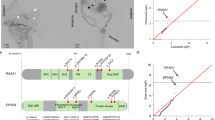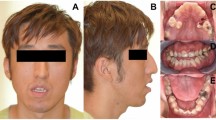Abstract
Vascular anomalies (VAs), comprising wide subtypes of tumors and malformations, are often caused by variants in multiple tyrosine kinase (TK) receptor signaling pathways including TIE2, PIK3CA and GNAQ/11. Yet, a portion of individuals with clinical features of VA do not have variants in these genes, suggesting that there are undiscovered pathogenic factors underlying these patients and possibly with overlapping phenotypes. Here, we identified one rare non-synonymous variant (c.968A > G) in the seventh exon of GPAA1 (Glycosylphosphatidylinositol Anchor Attachment Protein 1), shared by the four affected members of a large pedigree with multiple types of VA using whole-exome sequencing. GPAA1 encodes a glycosylphosphatidylinositol (GPI) transamidase complex protein. This complex orchestrates the attachment of the GPI anchor to the C terminus of precursor proteins in the endoplasmic reticulum (ER). We showed such variant led to scarce expression of GPAA1 protein in vascular endothelium and induced a localization change from ER membrane to cytoplasm and nucleus. In addition, expressing wild-type GPAA1 in endothelial cells had an effect to inhibit cell proliferation and migration, while expressing variant GPAA1 led to overgrowth and overmigration, indicating a loss of the quiescent status. Finally, a gpaa1-deficient zebrafish model displayed several types of developmental defects as well as vascular dysplasia, demonstrating that GPAA1 is involved in angiogenesis and vascular remodeling. Altogether, our results indicate that the rare coding variant in GPAA1 (c.968A > G) is causally related to familial forms of VAs.




Similar content being viewed by others
Abbreviations
- VA:
-
Vascular anomaly
- IH:
-
Infantile hemangioma
- CH:
-
Congenital hemangioma
- CM:
-
Capillary malformation
- VM:
-
Venous malformation
- CVM:
-
Cavernous venous malformation
- TK:
-
Tyrosine kinase
- VMCM:
-
Mucocutaneous venous malformation
- PIK3CA:
-
Catalytic subunit of class I phosphoinositide 3-kinases
- LM:
-
Lymphatic malformation
- EC:
-
Endothelial cell
- GNAQ:
-
Guanine nucleotide-binding protein G(q) subunit alpha
- GNA11:
-
Guanine nucleotide-binding protein subunit alpha-11
- GPI:
-
Glycosylphosphatidylinositol
- GPIT:
-
GPI transamidase
- GPAA1:
-
Glycosylphosphatidylinositol Anchor Attachment Protein 1
- PIG-U:
-
Phosphatidylinositol Glycan Class U
- PIG-S:
-
Phosphatidylinositol Glycan Class S
- PIG-T:
-
Phosphatidylinositol Glycan Class T
- Gpi8:
-
Phosphatidylinositol Glycan Class K
- ER:
-
Endoplasmic reticulum
- WES:
-
Whole-exome sequencing
- NGS:
-
Next-generation sequencing
- GATK:
-
Genome Analysis Toolkit
- MAF:
-
Minor allele frequency
- sgRNA:
-
Small guide RNA
- SD:
-
Standard control
- MO:
-
Morpholinos
- GPI-AP:
-
GPI-anchored protein
- AVM:
-
Arteriovenous malformation
- HUVEC:
-
Human umbilical vein endothelial cell
- dpf:
-
Days postfertilization
- CVP:
-
Caudal vein plexus
- DA:
-
Dorsal artery
- VV:
-
Ventral vein
- DV:
-
Dorsal vein
- CADD:
-
Combined Annotation Dependent Depletion
- SIFT:
-
Sortig Intolerant From Tolerant
References
Al-Olabi L et al (2018) Mosaic RAS/MAPK variants cause sporadic vascular malformations which respond to targeted therapy. J Clin Investig 128:5185. https://doi.org/10.1172/JCI124649
Ayturk UM et al (2016) Somatic activating mutations in GNAQ and GNA11 are associated with congenital hemangioma. Am J Hum Genet 98:1271. https://doi.org/10.1016/j.ajhg.2016.05.010
Barnes CM, Christison-Lagay EA, Folkman J (2007) The placenta theory and the origin of infantile hemangioma. Lymphat Res Biol 5:245–255. https://doi.org/10.1089/lrb.2007.1018
Bonavolonta G, Strianese D, Grassi P, Comune C, Tranfa F, Uccello G, Iuliano A (2013) An analysis of 2,480 space-occupying lesions of the orbit from 1976 to 2011. Ophthalmic Plast Reconstr Surg 29:79–86. https://doi.org/10.1097/IOP.0b013e31827a7622
Cai Y, Schrenk S, Goines J, Davis GE, Boscolo E (2019) Constitutive active mutant TIE2 induces enlarged vascular lumen formation with loss of apico-basal polarity and pericyte recruitment. Sci Rep 9:12352. https://doi.org/10.1038/s41598-019-48854-2
Castel P et al (2016) Somatic PIK3CA mutations as a driver of sporadic venous malformations. Sci Transl Med 8:332ra342. https://doi.org/10.1126/scitranslmed.aaf1164
Choi J, Dong L, Ahn J, Dao D, Hammerschmidt M, Chen JN (2007) FoxH1 negatively modulates flk1 gene expression and vascular formation in zebrafish. Dev Biol 304:735–744. https://doi.org/10.1016/j.ydbio.2007.01.023
Couto JA et al (2016) Endothelial cells from capillary malformations are enriched for somatic GNAQ mutations. Plast Reconstr Surg 137:77e–82e. https://doi.org/10.1097/PRS.0000000000001868
Dompmartin A, Vikkula M, Boon LM (2010) Venous malformation: update on aetiopathogenesis, diagnosis and management. Phlebology 25:224–235. https://doi.org/10.1258/phleb.2009.009041
Du Z, Zheng J, Zhang Z, Wang Y (2017) Review of the endothelial pathogenic mechanism of TIE2-related venous malformation. J Vasc Surg Venous Lymphat Disord 5:740–748. https://doi.org/10.1016/j.jvsv.2017.05.001
Eisenhaber B, Eisenhaber S, Kwang TY, Gruber G, Eisenhaber F (2014) Transamidase subunit GAA1/GPAA1 is a M28 family metallo-peptide-synthetase that catalyzes the peptide bond formation between the substrate protein's omega-site and the GPI lipid anchor's phosphoethanolamine. Cell Cycle 13:1912–1917. https://doi.org/10.4161/cc.28761
Gupta V et al (2011) The zebrafish dag1 mutant: a novel genetic model for dystroglycanopathies. Hum Mol Genet 20:1712–1725. https://doi.org/10.1093/hmg/ddr047
Jackson IT, Carreno R, Potparic Z, Hussain K (1993) Hemangiomas, vascular malformations, and lymphovenous malformations: classification and methods of treatment. Plast Reconstr Surg 91:1216–1230. https://doi.org/10.1097/00006534-199306000-00006
Jin SW et al (2007) A transgene-assisted genetic screen identifies essential regulators of vascular development in vertebrate embryos. Dev Biol 307:29–42. https://doi.org/10.1016/j.ydbio.2007.03.526
Kanada KN, Merin MR, Munden A, Friedlander SF (2012) A prospective study of cutaneous findings in newborns in the United States: correlation with race, ethnicity, and gestational status using updated classification and nomenclature. J Pediatr 161:240–245. https://doi.org/10.1016/j.jpeds.2012.02.052
Kinoshita T (2014) Enzymatic mechanism of GPI anchor attachment clarified. Cell Cycle 13:1838–1839. https://doi.org/10.4161/cc.29379
Knaus A et al (2019) Mutations in PIGU impair the function of the GPI transamidase complex, causing severe intellectual disability, epilepsy, and brain anomalies. Am J Hum Genet 105:395–402. https://doi.org/10.1016/j.ajhg.2019.06.009
Kurek KC et al (2012) Somatic mosaic activating mutations in PIK3CA cause CLOVES syndrome. Am J Hum Genet 90:1108–1115. https://doi.org/10.1016/j.ajhg.2012.05.006
Limaye N et al (2009) Somatic mutations in angiopoietin receptor gene TEK cause solitary and multiple sporadic venous malformations. Nat Genet 41:118–124. https://doi.org/10.1038/ng.272
Limaye N et al (2015) Somatic activating PIK3CA mutations cause venous malformation. Am J Hum Genet 97:914–921. https://doi.org/10.1016/j.ajhg.2015.11.011
Luks VL et al (2015) Lymphatic and other vascular malformative/overgrowth disorders are caused by somatic mutations in PIK3CA. J Pediatr 166:1048–1054. https://doi.org/10.1016/j.jpeds.2014.12.069(e1041–1045)
Maclellan RA et al (2014a) PIK3CA activating mutations in facial infiltrating lipomatosis. Plast Reconstr Surg 133:12e–19e. https://doi.org/10.1097/01.prs.0000436822.26709.7c
Maclellan RA et al (2014b) Expression of follicle-stimulating hormone receptor in vascular anomalies. Plast Reconstr Surg 133:344e–351e. https://doi.org/10.1097/01.prs.0000438458.60474.fc
McKenna A et al (2010) The Genome Analysis Toolkit: a MapReduce framework for analyzing next-generation DNA sequencing data. Genome Res 20:1297–1303. https://doi.org/10.1101/gr.107524.110
Mulliken JB, Glowacki J (1982) Hemangiomas and vascular malformations in infants and children: a classification based on endothelial characteristics. Plast Reconstr Surg 69:412–422. https://doi.org/10.1097/00006534-198203000-00002
Munden A et al (2014) Prospective study of infantile haemangiomas: incidence, clinical characteristics and association with placental anomalies. Br J Dermatol 170:907–913. https://doi.org/10.1111/bjd.12804
Murakami Y et al (2019) Mutations in PIGB cause an inherited GPI biosynthesis defect with an axonal neuropathy and metabolic abnormality in severe cases. Am J Hum Genet 105:384–394. https://doi.org/10.1016/j.ajhg.2019.05.019
Nagpal JK et al (2008) Profiling the expression pattern of GPI transamidase complex subunits in human cancer. Mod Pathol 21:979–991. https://doi.org/10.1038/modpathol.2008.76
Ng BG, Freeze HH (2015) Human genetic disorders involving glycosylphosphatidylinositol (GPI) anchors and glycosphingolipids (GSL). J Inherit Metab Dis 38:171–178. https://doi.org/10.1007/s10545-014-9752-1
Nguyen TTM et al (2017) Mutations in GPAA1, encoding a GPI transamidase complex protein, cause developmental delay, epilepsy, cerebellar atrophy, and osteopenia. Am J Hum Genet 101:856–865. https://doi.org/10.1016/j.ajhg.2017.09.020
Ohishi K, Inoue N, Kinoshita T (2001) PIG-S and PIG-T, essential for GPI anchor attachment to proteins, form a complex with GAA1 and GPI8. EMBO J 20:4088–4098. https://doi.org/10.1093/emboj/20.15.4088
Osaki TH, Jakobiec FA, Mendoza PR, Lee Y, Fay AM (2013) Immunohistochemical investigations of orbital infantile hemangiomas and adult encapsulated cavernous venous lesions (malformation versus hemangioma). Ophthalmic Plast Reconstr Surg 29:183–195. https://doi.org/10.1097/IOP.0b013e31828b0f1f
Patel MM et al (2018) Role of ADTRP (androgen-dependent tissue factor pathway inhibitor regulating protein) in vascular development and function. J Am Heart Assoc 7:e010690. https://doi.org/10.1161/JAHA.118.010690
Rootman J, Heran MK, Graeb DA (2014) Vascular malformations of the orbit: classification and the role of imaging in diagnosis and treatment strategies*. Ophthalmic Plast Reconstr Surg 30:91–104. https://doi.org/10.1097/IOP.0000000000000122
Samuels Y et al (2004) High frequency of mutations of the PIK3CA gene in human cancers. Science 304:554. https://doi.org/10.1126/science.1096502
Shields JA, Shields CL, Scartozzi R (2004) Survey of 1264 patients with orbital tumors and simulating lesions: the 2002 Montgomery Lecture, part 1. Ophthalmology 111:997–1008. https://doi.org/10.1016/j.ophtha.2003.01.002
Shirley MD et al (2013) Sturge-Weber syndrome and port-wine stains caused by somatic mutation in GNAQ. N Engl J Med 368:1971–1979. https://doi.org/10.1056/NEJMoa1213507
Soblet J, Limaye N, Uebelhoer M, Boon LM, Vikkula M (2013) Variable somatic TIE2 mutations in half of sporadic venous malformations. Mol Syndromol 4:179–183. https://doi.org/10.1159/000348327
Steiner JE, Drolet BA (2017) Classification of vascular anomalies: an update. Semin Intervent Radiol 34:225–232. https://doi.org/10.1055/s-0037-1604295
Stoletov K et al (2009) Vascular lipid accumulation, lipoprotein oxidation, and macrophage lipid uptake in hypercholesterolemic zebrafish. Circ Res 104:952–960. https://doi.org/10.1161/CIRCRESAHA.108.189803
Taghinia AH, Upton J (2018) Vascular anomalies. J Hand Surg Am 43:1113–1121. https://doi.org/10.1016/j.jhsa.2018.03.046
Thornhill P, Bassett D, Lochmuller H, Bushby K, Straub V (2008) Developmental defects in a zebrafish model for muscular dystrophies associated with the loss of fukutin-related protein (FKRP). Brain 131:1551–1561. https://doi.org/10.1093/brain/awn078
Traver D, Paw BH, Poss KD, Penberthy WT, Lin S, Zon LI (2003) Transplantation and in vivo imaging of multilineage engraftment in zebrafish bloodless mutants. Nat Immunol 4:1238–1246. https://doi.org/10.1038/ni1007
Uebelhoer M, Boon LM, Vikkula M (2012) Vascular anomalies: from genetics toward models for therapeutic trials. Cold Spring Harb Perspect Med. https://doi.org/10.1101/cshperspect.a009688
Vikkula M et al (1996) Vascular dysmorphogenesis caused by an activating mutation in the receptor tyrosine kinase TIE2. Cell 87:1181–1190. https://doi.org/10.1016/s0092-8674(00)81814-0
Wallez Y, Huber P (2008) Endothelial adherens and tight junctions in vascular homeostasis, inflammation and angiogenesis. Biochem Biophys Acta 1778:794–809. https://doi.org/10.1016/j.bbamem.2007.09.003
Wassef M et al (2015) Vascular anomalies classification: recommendations from the international society for the study of vascular anomalies. Pediatrics 136:e203–214. https://doi.org/10.1542/peds.2014-3673
Wooderchak-Donahue WL et al (2013) BMP9 mutations cause a vascular-anomaly syndrome with phenotypic overlap with hereditary hemorrhagic telangiectasia. Am J Hum Genet 93:530–537. https://doi.org/10.1016/j.ajhg.2013.07.004
Wouters V et al (2010) Hereditary cutaneomucosal venous malformations are caused by TIE2 mutations with widely variable hyper-phosphorylating effects. Eur J Hum Genet 18:414–420. https://doi.org/10.1038/ejhg.2009.193
Zhao P et al (2012) Proteomic identification of glycosylphosphatidylinositol anchor-dependent membrane proteins elevated in breast carcinoma. J Biol Chem 287:25230–25240. https://doi.org/10.1074/jbc.M112.339465
Acknowledgements
This research was supported by the National Natural Science Foundation of China (Grants 81570884 and 81770961) and Innovative research team of high-level local universities in Shanghai. The funders played no role in the study design, data collection and analysis, decision to publish, or the preparation of the manuscript.
Author information
Authors and Affiliations
Contributions
RJ, YL and LY designed and performed the experiments; YL, JY and JS were responsible for the animal model; YL, PC, SG and YW analyzed the data; YL, XF and RJ drafted the manuscript. All authors read and approved the final manuscript.
Corresponding author
Ethics declarations
Conflict of interest
The authors have declared that no conflict of interest exists.
Additional information
Publisher's Note
Springer Nature remains neutral with regard to jurisdictional claims in published maps and institutional affiliations.
Electronic supplementary material
Below is the link to the electronic supplementary material.

439_2020_2192_MOESM3_ESM.jpg
Supplementary file3 Supplementary Figure 1. Variant detection at c.968A of GPAA1 in 20 sporadic VA patients. (A) Sanger sequencing showed no variant was found at c.958A of GPAA1 in 20 sporadic VA patients. (B) The table demonstrated the disease of each patient. (JPG 1977 kb)

439_2020_2192_MOESM4_ESM.jpg
Supplementary file4 Supplementary Figure 2. Expression pattern of zebrafish gpaa1 during embryonic development in gpaa1 morphants. (A)Fluorescent images of 24 hpf embryos injected with a reporter EGFP mRNA (left) and a reporter EGFP mRNA plus gpaa1 MO (right). (JPG 703 kb)
Rights and permissions
About this article
Cite this article
Li, Y., Yang, L., Yang, J. et al. A novel variant in GPAA1, encoding a GPI transamidase complex protein, causes inherited vascular anomalies with various phenotypes. Hum Genet 139, 1499–1511 (2020). https://doi.org/10.1007/s00439-020-02192-w
Received:
Accepted:
Published:
Issue Date:
DOI: https://doi.org/10.1007/s00439-020-02192-w




